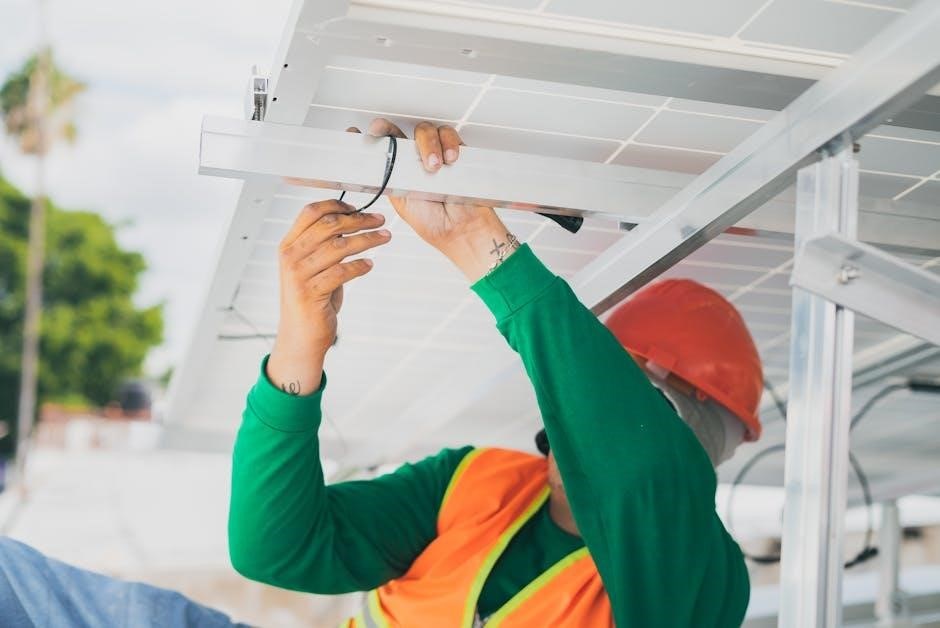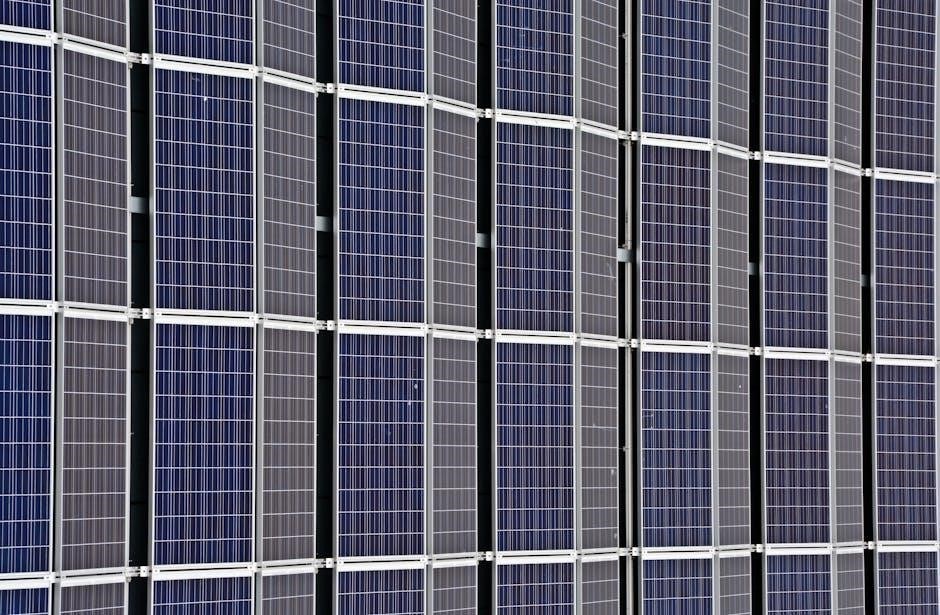12V solar panel systems are designed to operate at 12 volts, commonly used in RVs, boats, and small off-grid setups.
They consist of panels, charge controllers, batteries, and inverters, interconnected as visualized in wiring diagrams.

Understanding 12 Volt Solar Panel Systems
Basics of 12V Solar Power
12V solar power harnesses sunlight using photovoltaic (PV) panels, converting it into electricity. These systems are popular for off-grid applications, like RVs and boats, due to their simplicity and affordability.
The panels generate DC electricity, which is then regulated by a charge controller to safely charge 12V batteries. Stored energy in batteries can then be used directly to power 12V appliances or inverted to AC power for standard household devices.
Wiring diagrams are essential for proper installation and ensuring efficient energy conversion and storage within the system.

Components of a 12V Solar Panel System
A 12V solar panel system comprises key components like solar panels that convert sunlight into electricity, charge controllers regulating battery charging, batteries storing energy, and inverters converting DC to AC power.
Solar Panels
Solar panels are the primary energy source in a 12V system, converting sunlight into electricity. The selection of appropriate wattage and voltage is crucial for system efficiency. Wiring diagrams help connect panels correctly, whether in series or parallel, to achieve the desired voltage and current. Correct mounting is essential for optimum sun exposure. Different types of panels exist, each with varying efficiencies and suitability for specific applications. It’s also important to ensure that the panels are appropriately sized to work optimally with the charge controller. The wire used should also be of the correct type.
Charge Controllers
Charge controllers regulate the voltage from the solar panels to prevent overcharging the batteries, ensuring their longevity and safety. MPPT (Maximum Power Point Tracking) controllers optimize energy transfer, especially with higher voltage arrays. Wiring diagrams show how to connect the charge controller between the panels and batteries. Selecting the correct size controller is crucial to handle the panel’s output. It is important to choose an MPPT charge controller that will operate optimally for the array voltage. Incorrect wiring can damage the controller or the batteries; Always refer to the manufacturer’s instructions and wiring diagrams.
Batteries
Batteries store the energy generated by the solar panels for later use, providing power when sunlight is unavailable. 12V systems typically use lead-acid or lithium batteries, wired in parallel to increase capacity or series to increase voltage. Wiring diagrams illustrate proper battery connections to the charge controller and inverter. Correct battery sizing ensures sufficient energy storage for the application. Safety is paramount; proper fusing and wiring gauge are essential to prevent hazards. Consider using appropriately sized wire to properly connect your batteries. Incorrect wiring can cause damage or reduce the system’s efficiency. Always check polarity during connections.
Inverters
Inverters convert the 12V DC power stored in batteries to 120V AC, which is required to run most household appliances. Wiring diagrams show how to connect the inverter to the battery bank, often including fuses or circuit breakers for safety. Selecting the right inverter size is crucial to handle the load demands of your devices. Ensure the inverter’s wattage matches the total power consumption of your appliances. Proper grounding is essential for safety and to prevent electrical shocks. Always follow the manufacturer’s guidelines when installing and wiring the inverter. Remember to check the wiring diagrams to ensure correct connections.
Wiring Configurations for 12V Solar Panels
Wiring configurations for 12V solar panels include series, parallel, and series-parallel setups. These configurations determine the voltage and current output of the solar array, as shown in the wiring diagram.
Series Wiring
Series wiring involves connecting solar panels end-to-end, positive to negative, to increase the voltage while maintaining the same current. This configuration is useful when you need a higher voltage to match your charge controller or battery bank requirements. Refer to wiring diagrams to ensure correct connections, as improper wiring can lead to system inefficiencies or damage. Series connections are often used in systems with MPPT charge controllers to optimize energy harvesting.
Wiring in series increase voltage output, which is important if your charge controller requires a higher voltage. Always consult a reliable wiring diagram before making any connections.
Parallel Wiring
Parallel wiring connects solar panels side by side, positive to positive and negative to negative, to increase the current while maintaining the same voltage. This configuration is beneficial when you need more amperage to charge your batteries faster or power larger loads. Wiring diagrams illustrate how to properly connect panels in parallel, ensuring balanced current distribution and preventing potential issues. This method is suitable for systems where the voltage matches the battery bank. Correct parallel wiring maximizes the efficiency and lifespan of your solar panel system, as depicted in detailed wiring diagrams.
Series-Parallel Wiring
Series-parallel wiring combines both series and parallel connections to achieve desired voltage and current levels. This configuration involves connecting panels in series to increase voltage, then connecting these series strings in parallel to increase current. Wiring diagrams for series-parallel setups are more complex but offer greater flexibility in system design. This method is useful when matching specific voltage and current requirements of your battery bank or inverter. Proper series-parallel wiring, as shown in detailed diagrams, ensures efficient power delivery and system stability. Correctly implementing this configuration is crucial for optimal solar energy utilization.
Importance of Wiring Diagrams
Wiring diagrams are crucial for safe and efficient solar panel installations. They provide a visual guide, ensuring correct connections and minimizing risks. Diagrams help prevent polarity issues and optimize system performance.
Safety Considerations
Safety is paramount when working with electrical systems. Wiring diagrams are vital for ensuring correct connections, reducing the risk of electrical shocks and fires. Always disconnect solar modules and external fuses before installation.
Incorrect wiring can lead to short circuits or reverse polarity issues, damaging equipment and posing safety hazards. Using a wiring diagram helps prevent these errors. Ensure proper cable assembly and terminal connections based on recommended specifications.
The diagram assists in correctly wiring batteries, 12V systems, solar charging components, and inverter setups. Proper grounding is also critical, which the diagram should clearly illustrate to avoid potential grounding faults.
Optimizing System Performance
Wiring diagrams are key for optimizing the performance of 12V solar systems.
They ensure components are connected in a way that maximizes energy harvest and minimizes losses. For example, a diagram helps determine the best wiring configuration (series, parallel, or series-parallel) to match the solar array voltage to the battery bank.
Using the correct wire gauge, as specified in the diagram, reduces voltage drop and improves efficiency. An accurate diagram also guides the proper connection of MPPT charge controllers, ensuring they operate optimally.
Properly implemented, diagrams help you select the right solar kit with the required components.

Where to Find 12V Solar Panel Wiring Diagram PDFs
PDF wiring diagrams can be found on manufacturer websites for solar panels, charge controllers, and inverters. These resources provide detailed, product-specific information for safe and effective system installation and configuration.
Manufacturer Websites
Visiting the manufacturer’s website is a primary step in locating accurate wiring diagrams for 12V solar panel systems. Manufacturers often provide comprehensive documentation tailored to their specific products, including solar panels, charge controllers, and inverters. These resources typically include detailed wiring diagrams in PDF format, offering clear visual representations of the necessary connections.
These diagrams often provide step-by-step instructions and safety guidelines, ensuring proper installation and operation. Furthermore, manufacturer websites may offer additional resources such as technical specifications, troubleshooting guides, and customer support, enhancing the overall understanding and usability of the solar panel system. Checking the manufacturer’s website is an essential step in ensuring a safe and efficient installation process.
Online Forums and Communities
Exploring online forums and communities dedicated to solar power and DIY electrical projects can uncover a wealth of wiring diagrams. These platforms often host shared resources and discussions where experienced users and enthusiasts exchange knowledge and provide assistance. Members may upload wiring diagrams in PDF format, tailored to specific 12V solar panel configurations.
Such diagrams often come with real-world insights, practical tips, and troubleshooting advice from those who have implemented similar systems. Engaging in these forums allows individuals to ask questions, clarify doubts, and receive personalized guidance, making the installation process smoother and more informed. Be sure to vet the diagrams.
Common Mistakes to Avoid When Wiring Solar Panels
Using the incorrect wire gauge is a common mistake. Undersized wires can overheat, causing inefficiency and fire hazards. Always consult a wiring diagram to determine the appropriate gauge for your system’s amperage.
Incorrect Wire Gauge
Using an incorrect wire gauge is a prevalent mistake when wiring solar panels, potentially leading to serious problems. Wires that are too thin for the current they carry can overheat, causing a significant loss of efficiency and even posing a fire hazard. It’s crucial to consult a comprehensive wiring diagram to ascertain the correct wire gauge required for your specific solar panel system. This diagram should take into account the amperage of the system, the distance the electricity needs to travel, and any relevant safety codes or regulations. Proper wire gauge selection ensures safe and efficient operation.
Polarity Issues
Reversing polarity, connecting positive to negative or vice versa, is a serious wiring error with potentially damaging consequences. Incorrect polarity can destroy equipment like charge controllers and batteries, leading to costly repairs or replacements. Wiring diagrams clearly show positive and negative connections, and following them precisely is essential. Many systems include polarity protection features, but relying solely on these is risky. Always double-check connections using a multimeter to verify correct polarity before powering on the system. This simple step can prevent significant damage and ensure safe operation. Take extra care with color-coded wires, as conventions can vary.

Applications of 12V Solar Panel Systems
12V solar panel systems are popular for powering appliances and electronics in recreational vehicles and camper vans. These systems offer a renewable energy source for off-grid adventures, using wiring diagrams for proper installation.
RV and Camper Van Conversions
12V solar panel systems are a staple in RV and camper van conversions, providing a sustainable power source for various onboard appliances and electronics. Wiring diagrams are critical for correct and safe installations, ensuring the solar panels, charge controller, batteries, and inverter are properly connected. These diagrams help in setting up systems that can power lights, refrigerators, and other essential amenities while off-grid. Many resources, including PDFs from manufacturers and online communities, offer detailed wiring guidance tailored to specific RV and van setups. Properly wired 12V systems enhance the self-sufficiency and comfort of mobile living;
Emergency Backup Power Systems
12V solar panel systems are invaluable for emergency backup power, providing a reliable source of electricity during outages. Wiring diagrams are essential for setting up these systems correctly, ensuring that solar panels, charge controllers, batteries, and inverters work harmoniously. These diagrams guide users in creating systems capable of powering essential devices like lights, communication equipment, and medical devices. Resources such as manufacturer websites and online forums provide detailed PDF wiring diagrams for various emergency power configurations. Proper wiring ensures the system can efficiently store solar energy and deliver power when needed most, enhancing preparedness and safety during emergencies.
